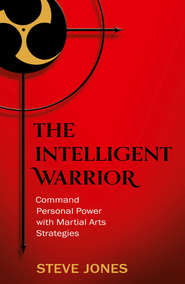
Полная версия:
The Intelligent Warrior: Command Personal Power with Martial Arts Strategies
The Basic Stance
Before beginning the practice of Meditation it is important to define the physical stance that you are going to adopt in order to meditate. The Chinese call this stance the ‘Mar Bou’ or ‘horse-riding stance’, and a variation of it exists in every martial art that I have ever studied. As my Martial Art studies continued, I realized that there was only one correct way for this stance to be taken in order to locate the body’s centre of gravity at the Tan T'ien, channel gravity correctly through the skeleton and finely tune the physiological balancing mechanisms in the body. When you stand correctly in Mar Bou the force of gravity holding you to the planet and your bodies center of gravity are brought together. The force of gravity holds us to the planet and holds the planets in orbit to each other and is a force of incomprehensible magnitude yet we can experience it directly as it flows through us. Every physical object has a center of gravity that is a place where the force of gravity predominates or concentrates when these two aspects (the force of gravity and it’s center of gravity) are not aligned then the object will be imbalanced. This is what occurs when you lean forward or back, the force of gravity moves up and away from your center of gravity. If you stand correctly in Mar Bou the force of gravity locates down into the Tan Tien (your center of gravity). Moreover the force of gravity has a tremendous effect on our blood supply when we stand correctly with a strong foundation the upper body can relax more which allows the force of gravity to pull the blood down in your body which induces a different blood circulation which helps to stop energy rising in your body. When Bodidharma (see here) originally instructed the monks in this stance he was quite specific: the feet should be parallel, the fists held upwards at the level of the waist, the knees slightly bent and the weight evenly distributed. In the original Kung Fu schools it was not uncommon for a new student to practice nothing but the Basic Stance for a year or longer, such was the importance that was placed upon it. It is the most balanced posture that a human being can stand in and by taking this physical posture you begin to affect your balance, which through the Principle of Resonation affects other areas of your functioning such as your mind and emotions. What follows is a description of this stance starting from the feet and working upwards to the top of the head. I will go into various aspects of ‘Mar Bou’ in more detail as you progress through the Meditation exercises, but for now follow the description whilst referring to Photographs 1 and 2. There are also instructional videos available for this and other techniques throughout the course of the book. Please click on the hyperlink next to the relevant technique to view it.
An introduction to the instructional videos can be found here: http://bmsmartialart.com/iwv
Marbou or the Basic Stance:
http://bmsmartialart.com/marbou-horse-riding-stance-iwv
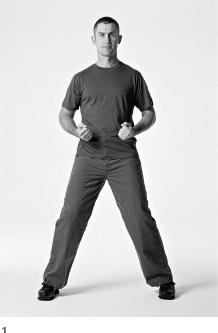
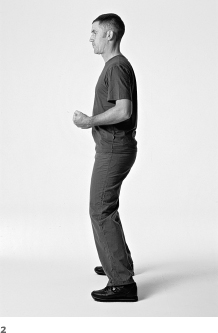
1 Stand with your feet slightly wider than shoulder width apart to provide a wider base and therefore more stability to your upright structure (see Align the Body). The wider you put your feet the more leverage you can get from the ground, but you lose mobility; the closer your feet are together the more mobility you can get, but you lose leverage.
2 Make sure that your feet are parallel to each other. This is crucial for correct alignment of the body – having your feet parallel is the natural placement for them, which means that the ligaments in the feet and the knees will be strengthened and balanced correctly in accordance with gravity (see The Art of Walking).
3 Bend slightly at the knees. Bending at the knees lowers the centre of gravity in the body, locating it to the Tan T'ien. Bending the knees works closely with the width of your stance to give you balance between power (from the ground) and mobility. The bend in the knees should allow you to drop your centre by approximately 6 inches, which is the optimum place for the centre of gravity to be located and also makes the body feel more grounded, which affects the mind and the emotions.
4 Make sure your spine is straight. A straight spine is the most essential ingredient in maintaining our biomechanical health. It also allows us to judge distance accurately (an indispensable self-defence skill).
5 Make sure you are not leaning forwards as in Photograph 3, or backwards as in Photograph 4.
6 Adjust the angle of your head by tucking your chin in slightly; try to feel that there is a string pulling you up from the top of your head.
7 Hold your hands in a loose fist at about the same level as the navel, gently touching the sides of the body. Tuck your thumbs outside the fist. The hands and arms are not essential for maintaining uprightness but we need to give them an exact form and place when meditating.
Take your time to learn the Basic Stance correctly. It might seem a bit boring but its effects on your health and your ability to practice holistic self-defence are far-reaching. It is this physical stance that forms the root of all other physical positions and techniques; also, by giving a precise form to our physicality we take a great step in bringing form to our thoughts and emotions.
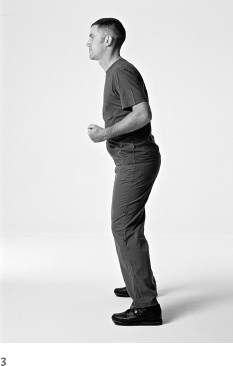
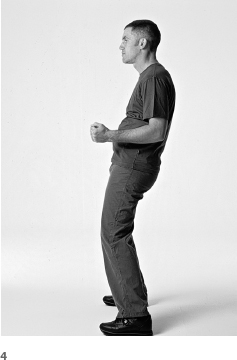
Inner Meditiation
Centring the Body
Balance is the all-important factor in a fighter's attitude or stance. Without balance at all times, he can never be effective. Bruce Lee (1975)
Centring the body involves connecting the mind to the physical centre of gravity of the body (the Tan T'ien). This centre is approximately one and a half inches below the navel, in the centre of the pelvis. It is the place that you were first nourished from via the umbilical cord and is at the level of the sacrum, which is the first bone made in the body. Both Eastern and Western medicine define the physical centre at this point, and to build a connection with your centre is to communicate with the very core and origins of your being. From a self-defence point of view, having a strong connection with the centre increases your balance and power and reduces the risk of falling.
To start with, this connection (referring back to the quotation at the beginning of this chapter) is made by our ‘intention’ from the mind (initiator) sending our ‘attention’ (capacity) to the area of the body (army) that is its centre. From there we begin to ‘play’ with the two primary mechanisms that allow us to have a sense of where the centre is exactly: pressure sensitivity in the legs and the balancing mechanisms in the inner ear. The placement of the centre is defined in three dimensions: left and right, forwards and back, up and down. By working with these three dimensions we can pinpoint an exact place inside the body that is the centre. These directions correspond to the three semicircular canals in the inner ear, which are filled with fluid and aligned to these dimensions.
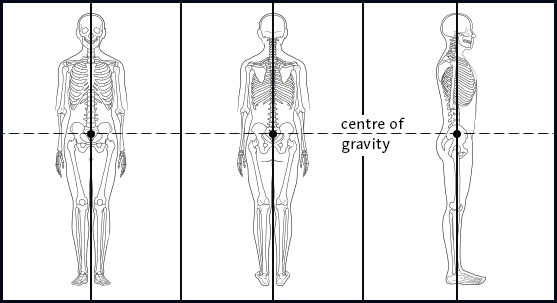
FIGURE 6
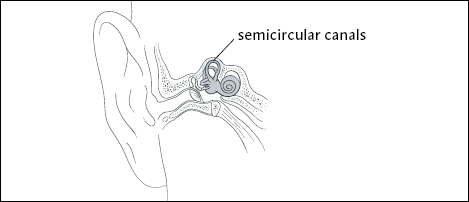
FIGURE 7
1 Left to Right If you look at the exercise to centre the body (here), you will see that the first movement oscillates between the left and right leg; this stimulates the pressure sensitivity in both legs. Pressure sensitivity in the legs is one of the main ways that we remain upright; the brain constantly uses the information from each leg to balance itself (it does this by sensing the amount of muscle tension present in each leg). If you think about walking, the pressure is passed from one foot to the other, and as you make your stride the pressure is balanced on each side to form an equal gait. If you have ever injured your foot you will have been reminded of this pressure moving from one side to the other – the moment you stand upright your body uses the pressure in the two legs to maintain its balance. As a martial artist you must develop sensitivity to this so that you become increasingly skilled at keeping a balance between the two legs.
2 Forwards and Back The next movement oscillates forwards and back (standing in the Basic Stance leaning forwards and leaning back), which stimulates the inner ear, one of the most extraordinary pieces of engineering in the body. As we lean forwards and back the fluid in the inner ear acts much like a builder's spirit level, providing vital information as to whether the head is level or not. The brain stem and the cerebellum (two of the areas of the brain that control reflex movement) are continually monitoring this information from the ear. If we lean too far forwards or back, the brain immediately makes us shift our feet and hands to ‘catch’ our balance. By evolving our sensitivity to this inner movement of energy, we protect the centre from being lost; if we lose the centre then very soon we will fall over and have to fight or defend ourselves from the ground.
3 Up and Down The last dimension is up and down (the vertical axis), arguably the most significant of them all as not only is it the most common way that we lose our centre but also the connection to this area helps to work against the body’s most powerful symptom of the fight-or-flight response: energy travelling upwards in your body. You will see in the exercise on centring the body that the vertical axis is found by relaxing and ‘sitting’ (similar to sitting down on a chair) into the Basic Stance, so it is a movement of relaxing where you instruct the muscles not necessary for standing to turn ‘off’. This is of tremendous significance because in any conflict situation our inner energy travels up and backwards simultaneously turning the muscles ‘on’ (tension). This type of reaction is the root of many popular sayings such as ‘to blow one’s lid’, or ‘to lose one's head’. Becoming in touch with the absolute truth of this statement is one of the keys to self-defence.
In any conflict situation (and we have gone to some length to describe what we mean by conflict) the first movement of self-defence must always be a relaxation and dropping towards the centre. This is not as easy as it would first appear because the aforementioned effect of fear in the body is of always moving the energy up and turning the muscles on. Therefore, by working with the exercise of centring, the body creates a deeper connection or movement towards the centre, and once we have found our centre everything else can orientate itself around it. The stronger the connection with the centre, the more of an anchor we have against this movement upwards of fear in the body.
Physical Imbalance
When we become physically imbalanced we lose our centre in a combination of the above dimensions (left, right, up, down, etc.). If you recall a time when you tripped and fell forwards, or jerked your head back away from something coming towards your head, you will already have a very real impression of physical imbalance. The Basic Stance is the most balanced position a human body can take, and relaxation is fundamental in order to adopt it correctly. When we relax, the body accepts the force of gravity through it (see Align the Body) and naturally begins to find its point of balance. We have evolved by nature an upright spine, so by relaxing and entering into this most balanced of postures we once again move closer to a natural state of being. That does not mean that we have to always walk around with a lowered centre of gravity, but in terms of applying self-defence techniques, the lowered centre is essential. When standing or moving generally in life we can still have this movement of relaxation and dropping down by connecting to our sense of the centre even if our legs are not bent and we are fully upright.
Mental Imbalance
Working with the physicality of the body is very tangible and we can feel it if we are in the present moment; by the Principle of Resonation this sense of balance then begins to teach the other areas of our being: the mind and emotions. Therefore, we begin to feel when our minds become imbalanced; the classic symptoms of this imbalance are a heightened internal conversation and projection into the future or the past with daydreams. For most of us this imbalance goes on all the time inside our heads, but when humans for one reason or another become chronically imbalanced we see this internal conversation starting to manifest itself outside ourselves. When this happens people talk aloud to themselves and actually begin to see their daydreams in the form of delusions and hallucinations. In this situation the internal imaginings take over control of the physical body and start to change its position correspondingly; this process happens in much more subtle ways with regular daydreaming. The balancing point for the mind is the present moment, which is the fulcrum between the past and future. To maintain this balance you as an Intelligent Warrior must develop the ability to quieten internal conversation and direct internal energy away from the part of the mind that generates daydreams.
Emotional Imbalance
Emotional imbalance always has a positive or negative charge so we either become overexcited, silly or ‘over the top’ or we indulge in negative emotions such as anger, self-pity, depression or self-loathing. Emotion is the quickest and most powerful energy in the body and for this reason it is the most ‘expensive’. If we become extremely enraged at something, it can take days for the body to rebalance itself. Recall a time when you became extremely emotional about something and remember how the emotional energy took over your physical body, perhaps contorting it into various positions, and how any rational thought was severely impaired. When we find the balancing point for emotions, which is always a sense of stillness, then we can begin to develop or evolve the emotions into feelings and allow them to take a more subtle form such as the composition of a piece of music, poetry or painting or the selection and execution of an appropriate self-defence technique.
The Three-Dimensional Point of Balance
The process of searching for balance can be well illustrated by the movement of a pendulum. To start with the pendulum swings in quite large movements from side to side and then gradually, as the force of gravity takes over, the movement decreases until it finds the point of balance (pointing straight down) and it comes to rest. This point of rest is a defining characteristic of your balance but it is not a complete point of rest or stagnation as it is always oscillating in tiny movements between the three dimensions. Think about a tightrope walker making very fine adjustments to stay on the tightrope or a child learning to ride a bike, wobbling from one side to the other until he or she finds a point of balance and stability. In humans the point of balance has many different expressions but the three primary characteristics are relaxation in the body, quietness in the mind and stillness in the emotions. The gradual development of balance through Meditation brings these characteristics to the surface and each can only truly be found in the present moment.
The Exercise of Centring
http://bmsmartialart.com/centring-exercise-iwv
Centring the body is an essential skill for the Intelligent Warrior for it allows you to hold two opposing forces in your awareness and find a balancing point between them. This is critical for applying intelligence to emotionally charged situations.
Left to Right
This exercise opens awareness to pressure sensitivity in the legs, a device the brain uses continuously to keep us upright, especially when walking.
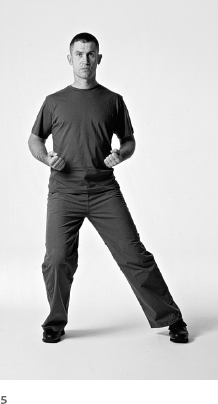

1 Stand in the Basic Stance (see here) and close your eyes.
2 Direct your intention down towards the area of the Tan T'ien (an inch and a half below the navel).
3 Slowly shift your weight from the left leg to the right in quite large motions, leaning quite far out over each leg (see Photograph 5).
4 Relax and be open to the impressions of the pressure as it increases in each leg as you move over it.
5 Gradually begin to decrease the movements. Perhaps think of the pendulum swinging from side to side as it begins to move to a point of rest.
6 Continue until you are only making very small movements but can still feel the pressure changing in the legs.
7 Finally, try to come to rest at the exact balancing point between the two legs.
Forwards and Back
This movement primarily stimulates the balance-sensing mechanism of the inner ear.
1 Slowly begin to rock forwards (see Photograph 7) and back (see Photograph 8) on your feet and feel your weight travelling from the heel to the ball the foot. Try to be sensitive to the place where if you went further you would begin to fall and would have to move your foot to catch your balance.
2 Without losing the sensation of the Tan T'ien, direct your attention to the area of the inner ear.
3 Repeat the process in the previous Right to Left exercise, gradually decreasing the movements until you find the balancing point.
Up and Down
1 Open to the sensation of relaxing and sitting into the Basic Stance, as if sitting down on a chair.
2 Push up slightly from the stance and then “sit” down into stance again into it.
3 Repeat this process, focusing on the sensation of the muscles that are necessary to push you up as opposed to the ones that are used for you to ‘sit’ into the stance.
4 Try very gently to keep renewing this movement of relaxation (letting go) as you sit down in the stance.
By making large movements to small ones our brain receives, via the pressure sensitivity in the legs and the balancing mechanisms in the inner ear, a wide range of movement from which it can compare the complementary opposites inherent in each section. By working in this way we gradually increase our sensitivity to the interplay between the opposites and become very sensitive to even the slightest movement away from the point of rest in any of the dimensions. This sensitivity means that we are aware sooner that our centre is becoming unstable and then, by the process of attention or presence in the body, we can correct it accurately with less chance of over-balancing in the opposite direction.
The up-and-down movement of relaxation may take a little while to get the hang of but by relaxing just enough you will become sensitive to the sensation of your weight locating down to the Tan T'ien. This movement of relaxation needs to be accompanied by a command to the muscles to ‘let go’. Remember, when you become nervous, stressed or afraid the body has a tendency to turn the muscles ‘on’, in other words tension creeps into the body; by practising the command to let go you are in effect giving the muscles the opposite command of ‘off’. It is in the conscious repetition of this command that you develop a strong enough connection to the musculature to relax when you have to face fear in your life.
After you have worked for a while in each of the three dimensions try searching for the centre in a circular movement pressing from left to forwards to right to back, gradually decreasing the concentric circles so as to combine the various dimensions simultaneously.
Align the Body
Balance is achieved only through correct body alignment. The feet, the legs, the trunk, the head are all important in creating and maintaining a balanced position. They are the vehicles of body force. Keeping the feet in proper relation to each other, as well as to the body, helps to maintain correct body alignment. Bruce Lee (1975)
Postural muscles, structurally adapted to resist prolonged gravitational stress, generally resist fatigue. When overly stressed, however the same postural muscles become irritable, tight shortened.
Chaitow, Bradley et al. (2002)
We do not recognise to what extent the intellectual, the emotional and moving (body) functions are mutually dependent, although, at the same time, we can be aware of how much our moods and our emotional states depend on our movements and postures. If a man assumes a posture that corresponds, in him, to the feeling of grief or dejection, then within a short time he will actually feel grief or dejection. Fear, indifference, aversion and so on may be created by artificial changes of posture. Gurdjieff (1976: 156)
The second exercise for Internal Meditation develops sensitivity to our verticality and its relationship with gravity. Our verticality is something that has evolved over a long time and is a fundamentally different situation to when our spine is in the horizontal position. You need to build awareness to your verticality so that in times of stress you can remain upright and because your verticality has a huge effect on your physical, mental and emotional wellbeing. When you awoke this morning your spine was horizontal to the ground where it had been participating in restorative, healing and rejuvenating functions. Then you hauled yourself into the upright position and your spine became vertical; from then on, you have been engaged in an act of balance. From a physiological point of view there are some profound changes that occur when your spine becomes vertical, for instance, your blood pressure changes, the breath mechanism is affected, and the movement of fluids around the body occurs in a dramatically different way. Our vertical spine has also had a profound effect on the evolution of our brain, especially the development of speech, but although this is a fascinating area of study I will not deal with it in any great depth at this point. However, it does help to have an appreciation of the differences between a horizontal and vertical spine.
For the most part our uprightness feels permanent, and we take it completely for granted. However, a closer inspection reveals that our ability to stand upright is anything but permanent – if our balance is disturbed then our spine will return to the horizontal position, in other words we will fall over. All processes of homeostasis take a continual input of energy and monitoring of balance to maintain them. Again, we wish to try to be ‘open’ to the physical reality of what is – in other words, how nature has built us – and not to use our imagination to construct an image; your verticality exists, you just need to build a deeper connection to it.
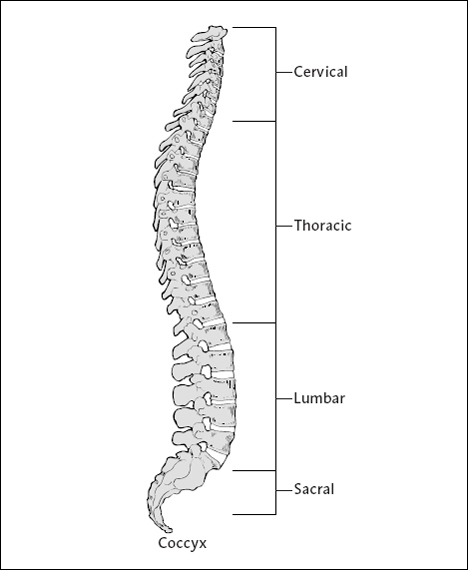
FIGURE 8
At the bottom half of our body sits a triangle. The base of the triangle is along the floor between the two feet. The two sides of the triangle are the legs, coming up at an angle to meet together at the pelvis; at exactly the point where they meet, we find the centre (Tan T'ien). On top of this triangle sits the spine, which is divided into three balanced sections: the lumbar, thoracic and cervical regions. Finally, perching on top of the spine, precisely where the primary organs of balance (the inner ear) are, is the head. These three areas: the triangular base, the spine and the head make up our basic alignment to gravity. Our arms, though important, are not essential for us to be upright. If you can build an ‘inner’ sensitivity to this basic shape of your alignment then your uprightness in times of stress, fear or panic will stand a much better chance of being maintained. This inner sense of alignment also plays a huge part in the overall maintenance of your health by continually monitoring and checking that the core of your body – the musculoskeletal system, which is the framework which all the other systems relate to – is as balanced as nature intended.



